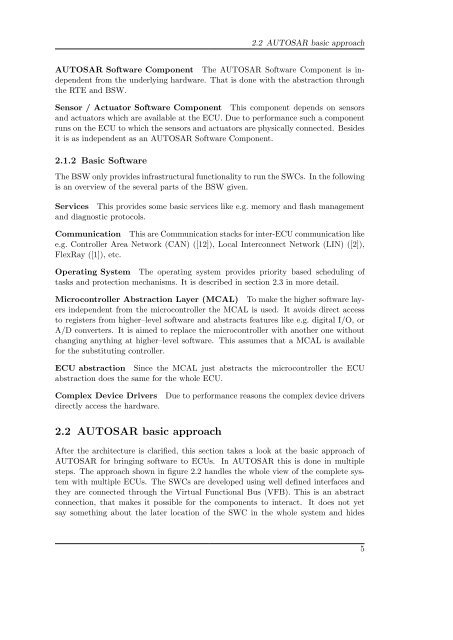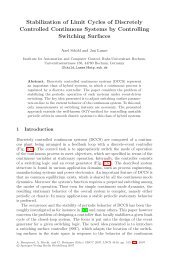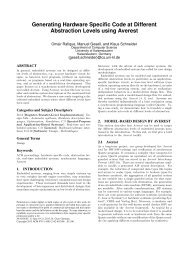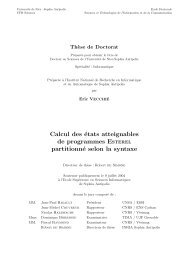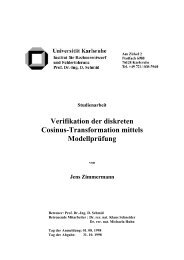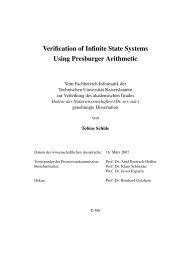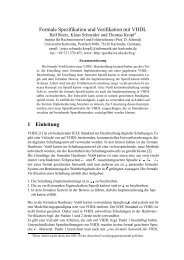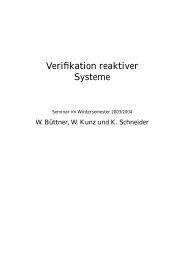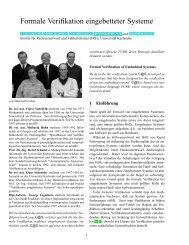Evaluation Environment for AUTOSAR-Autocode in Motor Control ...
Evaluation Environment for AUTOSAR-Autocode in Motor Control ...
Evaluation Environment for AUTOSAR-Autocode in Motor Control ...
Create successful ePaper yourself
Turn your PDF publications into a flip-book with our unique Google optimized e-Paper software.
2.2 <strong>AUTOSAR</strong> basic approach<br />
<strong>AUTOSAR</strong> Software Component The <strong>AUTOSAR</strong> Software Component is <strong>in</strong>dependent<br />
from the underly<strong>in</strong>g hardware. That is done with the abstraction through<br />
the RTE and BSW.<br />
Sensor / Actuator Software Component This component depends on sensors<br />
and actuators which are available at the ECU. Due to per<strong>for</strong>mance such a component<br />
runs on the ECU to which the sensors and actuators are physically connected. Besides<br />
it is as <strong>in</strong>dependent as an <strong>AUTOSAR</strong> Software Component.<br />
2.1.2 Basic Software<br />
The BSW only provides <strong>in</strong>frastructural functionality to run the SWCs. In the follow<strong>in</strong>g<br />
is an overview of the several parts of the BSW given.<br />
Services This provides some basic services like e.g. memory and flash management<br />
and diagnostic protocols.<br />
Communication This are Communication stacks <strong>for</strong> <strong>in</strong>ter-ECU communication like<br />
e.g. <strong>Control</strong>ler Area Network (CAN) ([12]), Local Interconnect Network (LIN) ([2]),<br />
FlexRay ([1]), etc.<br />
Operat<strong>in</strong>g System The operat<strong>in</strong>g system provides priority based schedul<strong>in</strong>g of<br />
tasks and protection mechanisms. It is described <strong>in</strong> section 2.3 <strong>in</strong> more detail.<br />
Microcontroller Abstraction Layer (MCAL) To make the higher software layers<br />
<strong>in</strong>dependent from the microcontroller the MCAL is used. It avoids direct access<br />
to registers from higher–level software and abstracts features like e.g. digital I/O, or<br />
A/D converters. It is aimed to replace the microcontroller with another one without<br />
chang<strong>in</strong>g anyth<strong>in</strong>g at higher–level software. This assumes that a MCAL is available<br />
<strong>for</strong> the substitut<strong>in</strong>g controller.<br />
ECU abstraction S<strong>in</strong>ce the MCAL just abstracts the microcontroller the ECU<br />
abstraction does the same <strong>for</strong> the whole ECU.<br />
Complex Device Drivers Due to per<strong>for</strong>mance reasons the complex device drivers<br />
directly access the hardware.<br />
2.2 <strong>AUTOSAR</strong> basic approach<br />
After the architecture is clarified, this section takes a look at the basic approach of<br />
<strong>AUTOSAR</strong> <strong>for</strong> br<strong>in</strong>g<strong>in</strong>g software to ECUs. In <strong>AUTOSAR</strong> this is done <strong>in</strong> multiple<br />
steps. The approach shown <strong>in</strong> figure 2.2 handles the whole view of the complete system<br />
with multiple ECUs. The SWCs are developed us<strong>in</strong>g well def<strong>in</strong>ed <strong>in</strong>terfaces and<br />
they are connected through the Virtual Functional Bus (VFB). This is an abstract<br />
connection, that makes it possible <strong>for</strong> the components to <strong>in</strong>teract. It does not yet<br />
say someth<strong>in</strong>g about the later location of the SWC <strong>in</strong> the whole system and hides<br />
5


